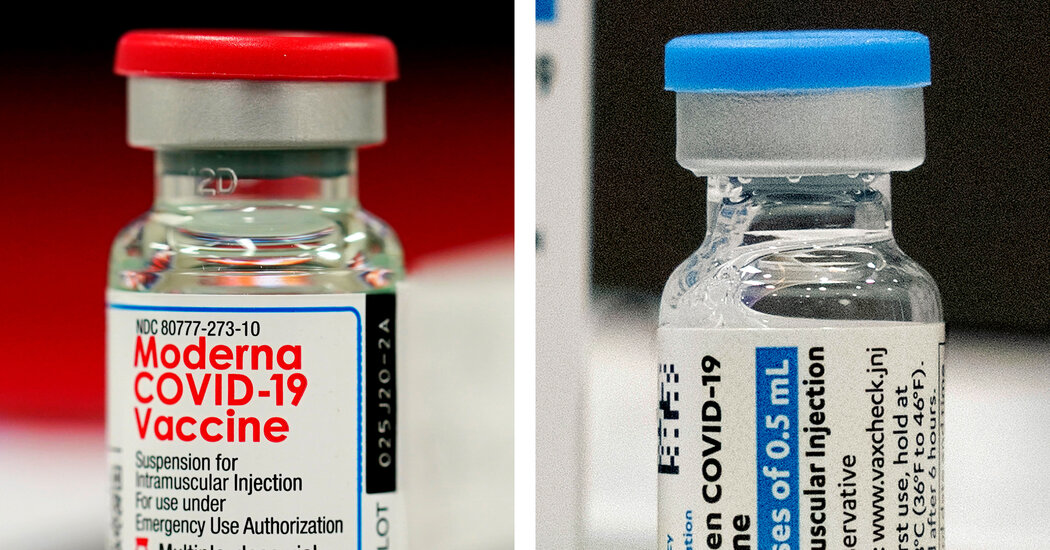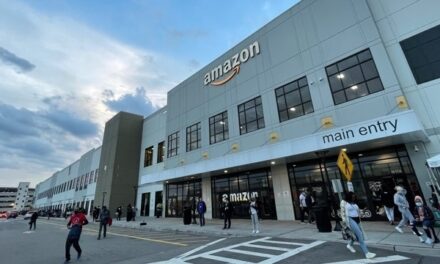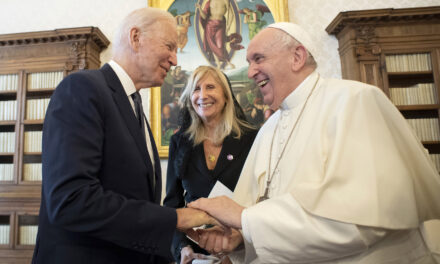
C.D.C. Panel Will Debate Booster Shots and Mix-and-Match Strategy

Image

As the latest wave of the virus ebbs in most parts of the United States, advisers to the Centers for Disease Control and Prevention will meet on Thursday to evaluate which Americans need extra doses of the coronavirus vaccines made by Moderna and Johnson & Johnson.
They will also discuss the so-called mix-and-match strategy — whether people fully immunized with one company’s vaccine should be allowed to switch to a different one for their booster shot.
On Wednesday, the Food and Drug Administration authorized booster shots for millions of people who received the Moderna and Johnson & Johnson vaccines, just as it did for recipients of Pfizer-BioNTech shots last month. The F.D.A. also gave the green light for people eligible for boosters to get an extra dose of a different brand from the one they first received.
But in practice who will get the shots and when depends greatly on the C.D.C.’s final guidance. Though the agency’s recommendations do not bind state and local officials, they hold great sway in the medical community.
Regardless of the tenor of the discussion, the final recommendations from the C.D.C.’s panel — the Advisory Committee on Immunization Practices — are unlikely to hold surprises. The committee is expected to endorse additional doses of the vaccines for many Americans and to bring the country closer to fulfilling President Biden’s promise to provide boosters to all adults.
It will not happen without some misgivings, however.
Some of the C.D.C.’s advisers last month voiced strong reservations about a booster of the Pfizer-BioNTech vaccine, saying the science did not support additional shots for anyone other than adults over 65. A majority voted to recommend booster shots for people with certain medical conditions that increase the risk of Covid-19.
The committee did not support boosters for people whose jobs expose them to the virus — but in a highly unusual move, Dr. Rochelle P. Walensky, the C.D.C.’s director, overturned their decision.
“It is going to be a difficult meeting, because I suspect that the science won’t have changed much,” said Dr. Sarah S. Long, a pediatrician and infectious diseases expert at Drexel University in Philadelphia. “I can see making it clear that we still don’t think this is the right approach, and Dr. Walensky would have to override it.”
A similar dynamic played out on the expert panel advising the F.D.A. at a meeting last week. Several advisers to the F.D.A. criticized the paucity of evidence supporting a Johnson & Johnson booster and expressed discomfort at having to decide on the booster before the F.D.A. had carefully vetted the data.
Still, they unanimously voted in favor of a second Johnson & Johnson shot for adults who had received that vaccine because it was clear that two doses would be more protective than one, according to one member of the panel, Dr. Paul A. Offit, director of the Vaccine Education Center at Children’s Hospital of Philadelphia.
“There was a value to having that as a one-dose vaccine when it first came out,” Dr. Offit said. “But I think it was always on the road to being a two-dose vaccine.”
He and others suggested that people who got the Johnson & Johnson vaccine might be better served by getting a second dose of the Pfizer-BioNTech or Moderna vaccines. The F.D.A. on Wednesday updated its authorization of all three vaccines, which will allow the C.D.C.’s advisory committee to recommend this mix-and-match strategy when it meets on Thursday.
At last week’s meeting, the F.D.A. advisers were shown evidence indicating that switching between two vaccine types might produce a richer immune response than boosting with the same vaccine.
San Francisco has offered Pfizer-BioNTech or Moderna shots to Johnson & Johnson recipients since August, and many Americans who initially received the Johnson & Johnson vaccine have sought out booster doses of those vaccines on their own before federal agencies had endorsed them.
But the F.D.A. advisers could not vote to recommend that people who initially got the Johnson & Johnson vaccine follow it up with one of the mRNA vaccines because the F.D.A. did not give them that option.
“The formal vote was on the J.-&-J. booster following the J.-&-J. vaccine,” said Dr. Stanley Perlman, an immunologist and coronavirus expert at the University of Iowa. But “everybody knew that the data would show that the heterologous boost would be better.” (Heterologous refers to a shot of a different vaccine.)
Image
India on Thursday celebrated having administered a billion doses of Covid vaccine, drawing on local manufacturing after devastating early stumbles in its pandemic response.
Still, the country has some way to go in fully vaccinating its population: Just 30 percent of the 900 million people eligible for vaccination in India have received two doses.
It was a turnaround in a vaccination drive that got off to a slow start, as India’s governing party prioritized elections and took up a lax attitude in tackling the virus, continuing to hold crowded political rallies and allowing religious festivals to take place even as cases surged.
“Gratitude to our doctors, nurses and all those who worked to achieve this feat,” Prime Minister Narendra Modi said on Twitter. More than 70 percent of adults have received at least one dose of vaccine, according to government figures. India is administering second doses 12 to 16 weeks after the first.
More than 450,000 people have died from Covid in India, according to government data that many experts say greatly downplays the true toll. India’s second wave earlier this year led to a shortage of medical care, oxygen, and hospital beds.
But the worst of the pandemic seems to be over, with India reporting about 15,000 new cases daily, down from a recorded peak of more than 400,000.
While other countries have struggled to secure enough doses to vaccinate their populations, India’s gigantic vaccination drive was made possible by domestic manufacturing capacity. The Serum Institute of India, the world’s largest vaccine maker, has supplied more than 80 percent of the doses administered in the country.
The demand for vaccines in India after the devastating second wave was such that the Serum Institute fell short on its commitments to supply vaccines to poorer nations. But as India’s situation stabilizes, vaccine exports from India — seen as crucial to global efforts — have slowly resumed.
The toll of the pandemic on India’s already slowing economy, however, will take years to reverse. The tourism industry is seeing some reprieve, as India last week began gradually welcoming foreign visitors after nearly two years. In the initial stage, only fully vaccinated tourists on charter flights are allowed in, before the country opens up to other tourists next month.
Dr. K. Srinath Reddy, the president of the Public Health Foundation of India, said the country could now hope to avoid a severe third wave unless a dangerous new variant emerged.
“At the moment it appears that while the vaccination doses are a good landmark, we should continue our caution in making sure that people are observing Covid-appropriate behavior, particularly with masks and not having super-spreading events until we actually reach a much higher level of vaccination,” he said.
Image
As New York City struggles to revive its economy after the devastation wrought by the pandemic on restaurants, hotels, theaters, tours, souvenir shops and the people who keep them running, one crucial element is still missing: big-spending foreign tourists.
Before the virus, the city was flooded with record numbers of visitors from Europe, Asia and South America. In 2019, they filled hotels, restaurants, Broadway theaters and museums, spending billions and fueling a surge in jobs. While American tourists have returned, the city can’t wait until Nov. 8, when the federal government is opening the country’s borders to vaccinated visitors. New York is preparing its most aggressive campaign in an effort to lure those visitors back in time to salvage, if it can, the end-of-year holiday season.
The city’s tourism agency, NYC & Company, plans to spend $6 million in eight countries on an advertising campaign themed “It’s Time for New York City,” with billboards trumpeting the message: “New York City Is Ready for You.”
Fred Dixon, the chief executive of the agency, said it would take years to regain all the lost tourism, but that the campaign could help. “There is an enormous amount of pent-up demand, and people are anxious to travel again,” he said.
Before the pandemic, tourists spent $47 billion annually and supported more than 280,000 jobs in the city, according to official estimates. About half of that came from international visitors, even though they accounted for just 20 percent of all tourists.
This year, the city’s tourism agency forecasts visitor spending of about $24 billion, half of the 2019 total.
Many New York businesses and workers say their survival depends on the robust return of international tourists.
“We’re hoping the city tries to bring back these international tourists because they’re our lifeline,” said Mohammed Rufai, an immigrant from Ghana who sells tickets in Times Square for a double-decker bus tour of Manhattan. “We need them.”
Mr. Rufai, 45, said he could earn $200 a day before the pandemic, more than 70 percent of it from other parts of the world. He now struggles to make half that.
“You cannot ask people to ride if there are no people here to ask,” he said.
Image
In-N-Out, the popular burger chain in California, was forced to close its only San Francisco outlet last week after it failed to comply with the city’s requirement that all restaurants check the vaccine cards of indoor diners.
The restaurant shut down all operations on Oct. 14, but it has since reopened for outdoor dining and takeout after implementing measures to comply with the mandate, the San Francisco Department of Public Health said in a statement on Wednesday.
“Public health officials directly informed In-N-Out Burger representatives multiple times about the proof-of-vaccination requirement,” the department said, adding that no other restaurant in the city had needed to be reminded.
In-N-Out did not immediately respond to a request for comment on Wednesday. But The San Francisco Chronicle reported that the chief legal and business officer for In-N-Out, Arnie Wensinger, said in a statement: “We refuse to become the vaccination police for any government.”
The chain has 257 locations in California, according to the company’s website.
The friction comes as the country continues to grapple with pandemic mandates, underscoring the challenges facing hospitality workers who, in some places, have been tasked with enforcing rules on mask-wearing and vaccinations.
The property’s owner was also issued a notice of violation, according to the city.
The department of public health said businesses have several options to operate that do not require vaccination check-ins.
“The vast majority of businesses have worked in partnership with the city to protect public health, understanding that the health and safety of our community remains our highest priority and our reopening is contingent on us getting the virus under control,” the department said.
On Twitter, the city’s approach was more jocular and included a tweet suggesting that the name of the restaurant could be changed to “In-N-Out(side).”
Image
WASHINGTON — The Food and Drug Administration on Wednesday authorized booster shots for tens of millions of recipients of Moderna’s two-dose coronavirus vaccine and the roughly 15 million who got Johnson & Johnson’s single-dose shot, significantly expanding the nation’s campaign to bolster protection for vulnerable people.
The agency also updated its authorizations for all three vaccines — Moderna, Johnson & Johnson and Pfizer-BioNTech — to allow medical providers to boost people with a different Covid-19 vaccine than the one they initially received, a strategy known as “mix and match.”
That update may dampen interest in Johnson & Johnson’s vaccine, which studies have found provides less protection than the other two. Providers will have the option of offering a Moderna or Pfizer-BioNTech booster, which could trigger a more substantial jump in protective antibodies.
The regulators, who already authorized boosters for high-risk Pfizer-BioNTech recipients last month, did not recommend any one vaccine over another as a booster. They also remained silent on whether it would be preferable to stick with the same vaccine when possible.
The latest authorizations arrived in the middle of a busy stretch of regulatory decisions on vaccines. The F.D.A. is expected in the coming weeks to decide on whether Pfizer and BioNTech’s vaccine should be authorized for children ages 5 to 11. The agency’s independent vaccine committee is set to vote Tuesday to consider the matter and make a recommendation.
Regulators may also decide as early as November whether to authorize boosters for younger Americans who are not at high risk. While many vaccine experts have questioned whether younger, healthy people need booster shots, some advisory committee members last week urged the agency to move to expand eligibility.
The F.D.A.’s move to make a much larger swath of Americans eligible for additional shots on Wednesday followed unanimous votes last week from a key advisory committee to recommend the authorizations. A separate committee advising the Centers for Disease Control and Prevention is scheduled to vote Thursday on its own recommendations for Moderna and Johnson & Johnson boosters.
The C.D.C. director typically endorses that panel’s recommendations as a final step before vaccines are put into use. If the agency agrees with the F.D.A.’s decision, booster shots could be offered as soon as this weekend.
Eligible Moderna recipients could get a half-dose booster of that vaccine at least six months after their second dose. Like Pfizer recipients, the eligible would include people 65 and older, and younger adults at high risk of severe Covid-19 because of medical conditions or where they work. Johnson & Johnson recipients — all of whom are 18 and older — will be eligible for a second shot at least two months after the first.
Image
Bulgaria began requiring residents to show proof of vaccination to eat at restaurants, attend movie theaters and enter shopping malls starting Thursday, as its government struggles with a wave of cases and vaccine hesitancy.
The country has the lowest vaccination rate of any European Union member, with about a quarter of adults fully vaccinated. On Tuesday, it reported a record number of new daily cases and 200 deaths linked to the coronavirus.
“The situation is critical,” the interim health minister, Dr. Stoycho Katsarov, said in a television interview on Wednesday. “The nation is facing tremendous hardship and most people cannot even reckon the scale of the calamity.”
He announced the tightened restrictions on Tuesday, after weeks of calls by public health officials for tighter measures.
People in Bulgaria who choose not to get vaccinated can show a recent negative test or proof of recovery from Covid-19 to enter indoor venues, and no proof is required to enter pharmacies, banks, public transport or grocery stores.
The measures also apply to hospital and nursing home employees, who must show a “green pass” to work.
As the number of new reported cases rises, already strained hospitals are struggling to accommodate the surge in patients. Schools in several districts have switched to online learning.
In the last two weeks, Bulgaria has had one of the highest mortality rates of any European Union country, according to the European Center for Disease Prevention and Control. Of coronavirus deaths in the past 24 hours, 94 percent were among the unvaccinated.
While vaccines are widely available, many Bulgarians have resisted vaccination because of rampant disinformation and mistrust in the authorities. Public health efforts have also been hampered by months of political instability, which left political parties reluctant to introduce vaccination mandates or other unpopular measures.
Unlike in Western Europe, very few political leaders have been vaccinated publicly. Boiko Borisov, the prime minister until the spring, received his first shot only at the end of July.
Some experts said the government had waited too long to introduce tighter restrictions. “New measures came too late,” said Dr. Radka Argirova, the head of the Bulgarian Virology Association. “We should have tightened the measures months ago.”
Shortly after the new measures were announced, several vaccination centers in the capital Sofia saw an increased demand for vaccines.
But there were also shows of resistance. On Wednesday, several hundred several hundred supporters of two small, far-right parties marched in Sofia, the capital, to protest the new rules.
— Boryana Dzhambazova
Image
While fully vaccinated Americans can fly to hundreds of cities and towns across the country and 27 European capitals, border rules across Asia remain far stricter than in any other region in the world.
Governments in Asia have promised to reopen their borders because of the improved Covid situation and progress on vaccinations. But they are falling behind the rest of the world. Air travel in August across the region was still 10 percent of what it was two years ago, lagging the rebound in the United States. Travelers must navigate an inconsistent patchwork of border restrictions, visa rules and travel corridors — one likely to continue for months.
Vaccinated travelers from a handful of countries, including Britain and Spain, won’t have to quarantine to visit Singapore. But Ireland and Portugal, which have comparable vaccination rates, didn’t make the list. And visitors from only four places in Asia — Hong Kong, Macau, China and Taiwan — may enter by applying for a special pass.
The list of eligible countries from which tourists can visit Indonesia is longer, with travelers from 19 countries cleared to visit Bali and the Riau Islands. People from India, which has vaccinated about a quarter of its population, are good to travel. But those from Malaysia, which has vaccinated 72 percent, or Singapore, 82 percent, aren’t yet welcome.
And the regulations in the Philippines have led to some confusion. Two tourists were sent back to Singapore after they arrived without the proper visas. They were not aware that the Philippines had only opened travel for business or humanitarian reasons.
Thailand is taking a different approach, requiring visitors not to make any stopovers. Tourists can go to the island of Phuket without quarantining if they arrive on a direct flight, and they can tour other parts of the country after seven days. Quarantine-free arrivals to the rest of Thailand will be open to vaccinated tourists from at least 10 countries starting Nov. 1, the authorities said last week.
South Korea has taken yet another path: Instead of allowing tourists to arrive from particular locations, it has allowed people of certain nationalities to visit without a visa. Tourists of one of 49 nationalities may apply for permission to visit.
But a separate list, based on where travelers arrive from, governs who has to undergo two weeks of quarantine on arrival in South Korea; the authorities are adding five countries to the list of those from which fully vaccinated travelers will not have to quarantine starting next month.
Fully vaccinated people flying in from Malawi, Bangladesh, Indonesia, Zambia and Chile will not be required to isolate for two weeks starting in November. Visitors from 16 nations will still need to quarantine, down from 20 in October.
South Korea also relaxed some social distancing regulations on Monday, after several months in which they have been at the highest level in the capital.
Most other countries in the region, including China and Japan, still require visas for vaccinated foreign travelers. Tourists have yet to get approval to enter.
Image
Bucking the trend in much of the Americas, several Caribbean countries are reporting significant surges in known coronavirus infections, World Health Organization officials warned on Wednesday.
Reports of new cases are up 40 percent over the last week in the Dominican Republic and Barbados, said Dr. Carissa F. Etienne, the director of the Pan American Health Organization, a division of the W.H.O.
“In fact,” Dr. Etienne said at a news conference, “half of Barbados’s cumulative Covid infections since the pandemic began have been reported in the last month.”
Cases are also rising in Trinidad and Tobago and some smaller island nations and territories in the region, including St. Martin, St. Kitts and Nevis, Anguilla and the Cayman Islands.
Many Caribbean countries have had difficulty moving quickly with vaccination efforts, both because of difficulty obtaining doses and because of widespread public hesitancy.
“It really troubles me that some of my Caribbean brothers and sisters have been slow to accept the Covid-19 vaccines that have been made available to them,” said Dr. Etienne, who is from Dominica.
Across Latin America and the Caribbean, 41 percent of the population has been fully vaccinated against Covid-19, according to the Pan American Health Organization.
New case reports are declining across North America, and infections and deaths are declining in most of Central America. The picture is also improving in South America, with the exception of Bolivia and Venezuela, the organization said.
Dr. Etienne said it was important for countries in the region to build up testing even as reports of new cases ebbed, so that any fresh outbreaks could be caught before they developed into widespread surges. “More and more, we’re seeing how local hot spots are driving national trends,” she said.
A good approach, she said, would be to integrate surveillance for Covid-19 with monitoring of other respiratory viruses. She said her organization was working with the Centers for Disease Control and Prevention in the United States to develop a new protocol for P.C.R. testing that would screen the same samples for both Covid-19 and influenza.
Strong surveillance networks, she said, could also help detect emerging pathogens before they spread, and serve “as the region’s backbone for pandemic preparedness.”
— Daniel Politi
Source: https://www.nytimes.com/live/2021/10/21/world/covid-vaccine-boosters


















